The Influence of Interlayer on the Development of Steam Chamber in Steam Stimulation during Heavy Oil Recovery
Abstract
:1. Introduction
2. Materials and Methods
2.1. Interlayer Preparation
2.1.1. Experimental Purpose
2.1.2. Experimental Drugs and Instruments
2.1.3. Experimental Method
2.2. D High-Pressure Physical Simulation Experiment of Top Water Breaking through Sandy Conglomerate Interlayer
2.2.1. Experiment Equipment
2.2.2. Experimental Design and Parameters
2.2.3. Experimental Method
3. Results and Discussion
3.1. Interlayer Fabrication
3.1.1. Screening of High-Temperature Resistant Resin Components
3.1.2. Selection of High-Temperature Resistant Resin Dosage
3.1.3. Performance Evaluation
3.2. 3D Physical Simulation
3.2.1. Temperature Distribution
3.2.2. Production Performance
4. Conclusions
- 1.
- A high-temperature-resistant resin for simulating the interlayer of a heavy oil reservoir was prepared. The resin is a low-viscosity liquid at room temperature, the curing time is 4.5 h at 50 °C, and the compressive strength is 29.36 MPa. After aging at 350 °C for 120 days, the compressive strength of the resin is still higher than 20 MPa, and the mass retention rate is more than 90%, which has good high-temperature resistance;
- 2.
- The results of the one-dimensional physical simulation experiment show that the simulated interlayer core and the actual interlayer core have similar sealing ability to steam, which provides a new technology for the physical simulation experiment of heterogeneous heavy oil reservoir;
- 3.
- Under the condition of no interlayer, CSS production can be divided into three stages. The later the breakthrough period, the higher the recovery rate. The existence of an interlayer influence period can delay the breakthrough time of steam and the top water, but also hinder the flow of crude oil;
- 4.
- The interlayer permeability and horizontal well position have a great influence on the production performance. For the top (low) water heavy oil reservoir, the deployment of horizontal wells can be far away from the top water and located below the low permeability interlayer, which is beneficial to improve the recovery rate.
Author Contributions
Funding
Data Availability Statement
Conflicts of Interest
References
- Guo, K.; Li, H.; Yu, Z. In-situ heavy and extra-heavy oil recovery: A review. Fuel 2016, 185, 886–902. [Google Scholar] [CrossRef]
- Dong, X.; Liu, H.; Chen, Z.; Wu, K.; Lu, N.; Zhang, Q. Enhanced oil recovery techniques for heavy oil and oilsands reservoirs after steam injection. Appl. Energy 2019, 239, 1190–1211. [Google Scholar] [CrossRef]
- Bai, Y.; Cao, Z.; Hu, Y.; Zhao, J.; Zhang, H. Highly thermoconductive biogel for enhancing thermal efficiency and soil self-remediation in heavy oil recovery. J. Clean. Prod. 2023, 398, 136643. [Google Scholar] [CrossRef]
- Xue, L.; Liu, P.; Zhang, Y. Development and Research Status of Heavy Oil Enhanced Oil Recovery. Geofluids 2022, 2022, 5015045. [Google Scholar] [CrossRef]
- Wang, Q.; Zheng, W.; Liu, J.; Cao, B.; Hao, J.; Lu, X.; Zheng, K.; Cui, L.; Cui, T.; Sun, H. Integration of Profile Control and Thermal Recovery to Enhance Heavy Oil Recovery. Energies 2022, 15, 7346. [Google Scholar] [CrossRef]
- Friedmann, F.; Smith, M.E.; Guice, W.R.; Gump, J.M.; Nelson, D.G. Steam-foam mechanistic field trial in the midway-sunset field. SPE Reserv. Eng. 1994, 9, 297–304. [Google Scholar] [CrossRef]
- Patzek, T.W. Field applications of steam foam for mobility improvement and profile control. SPE Reserv. Eng. 1996, 11, 79–86. [Google Scholar] [CrossRef]
- Gotawala, D.R.; Gates, I.D. Steam fingering at the edge of a steam chamber in a heavy oil reservoir. Can. J. Chem. Eng. 2008, 86, 1011–1022. [Google Scholar] [CrossRef]
- Fatemi, S.M. The effect of geometrical properties of reservoir shale barriers on the performance of steam-assisted gravity drainage (SAGD). Energy Sources Part A Recovery Util. Environ. Eff. 2012, 34, 2178–2191. [Google Scholar] [CrossRef]
- Lyu, X.; Liu, H.; Pang, Z.; Sun, Z. Visualized study of thermochemistry assisted steam flooding to improve oil recovery in heavy oil reservoir with glass micromodels. Fuel 2018, 218, 118–126. [Google Scholar] [CrossRef]
- Hou, J.; Wei, B.; Du, Q.; Wang, J.; Wang, Q.; Zhang, G. Production prediction of cyclic multi-thermal fluid stimulation in a horizontal well. J. Pet. Sci. Eng. 2016, 146, 949–958. [Google Scholar] [CrossRef]
- Yang, G.; Butler, R.M. Effects of reservoir heterogeneities on heavy oil recovery by steam-assisted gravity drainage. J. Can. Pet. Technol. 1992, 31, 37–43. [Google Scholar] [CrossRef]
- Ito, Y.; Hirata, T.; Ichikawa, M. The growth of the steam chamber during the early period of the UTF Phase B and Hangingstone Phase I projects. J. Can. Pet. Technol. 2001, 40. [Google Scholar] [CrossRef]
- Pooladi-Darvish, M.; Mattar, L. SAGD operations in the presence of overlying gas cap and water layer-effect of shale layers. J. Can. Pet. Technol. 2002, 41. [Google Scholar] [CrossRef]
- Ipek, G.; Frauenfeld, T.; Yuan, J.Y. Numerical study of shale issues in SAGD. In Proceedings of the Canadian International Petroleum Conference, Calgary, AB, Canada, 17–19 June 2008. OnePetro. [Google Scholar] [CrossRef]
- Chen, Q.; Gerritsen, M.G.; Kovscek, A.R. Effects of reservoir heterogeneities on the steam-assisted gravity-drainage process. SPE Reserv. Eval. Eng. 2008, 11, 921–932. [Google Scholar] [CrossRef]
- Shin, H.; Choe, J. Shale barrier effects on the SAGD performance. In Proceedings of the SPE/EAGE Reservoir Characterization & Simulation Conference, Abu Dhabi, United Arab Emirates, 19–21 October 2009; Cp-170-00012. EAGE Publications BV: Dubai, United Arab Emirates, 2009. [Google Scholar] [CrossRef]
- Le Ravalec, M.; Morlot, C.; Marmier, R.; Foulon, D. Heterogeneity impact on SAGD process performance in mobile heavy oil reservoirs. Oil Gas Sci. Technol.-Rev. IFP 2009, 64, 469–476. [Google Scholar] [CrossRef]
- Dang, T.Q.C.; Chen, Z.; Nguyen, T.B.N.; Bae, W.; Mai, C.L. Numerical simulation of SAGD recovery process in presence of shale barriers, thief zones, and fracture system. Pet. Sci. Technol. 2013, 31, 1454–1470. [Google Scholar] [CrossRef]
- Dang, C.T.Q.; Nguyen, N.T.B.; Bae, W.; Nguyen, H.X.; Tu, T.N.; Chung, T. Investigation of SAGD recovery process in complex reservoir. In Proceedings of the SPE Asia Pacific Oil and Gas Conference and Exhibition, Brisbane, Australia, 18–20 October 2010. [Google Scholar] [CrossRef]
- Zhou, Y.; Xi, C.; Wu, J. Effect of barriers on the SAGD performance result. In Proceedings of the International Petroleum Technology Conference, Beijing, China, 26–28 March 2013. [Google Scholar] [CrossRef]
- Xia, Y.; Huang, S.; Chen, X.; Cao, M.; Yang, L. Study on the characteristics of production performance and steam chamber of SAGD considering interlayer. In Proceedings of the SPE International Heavy Oil Conference and Exhibition, Kuwait City, Kuwait, 10–12 December 2018. [Google Scholar] [CrossRef]
- Huang, S.; Yang, L.; Xia, Y.; Du, M.; Yang, Y. An experimental and numerical study of a steam chamber and production characteristics of SAGD considering multiple barrier layers. J. Pet. Sci. Eng. 2019, 180, 716–726. [Google Scholar] [CrossRef]
- Zhang, L.; Li, J.; Sun, L.; Yang, F. An influence mechanism of shale barrier on heavy oil recovery using SAGD based on theoretical and numerical analysis. Energy 2021, 216, 119099. [Google Scholar] [CrossRef]
- Wei, S.; Duan, Y.; Wei, M.; Ren, K.; Lu, C.; Zhan, J.; Tang, Y. Experimental study on the effect of different distributed interlayer on SAGD performance. J. Pet. Sci. Eng. 2022, 209, 109827. [Google Scholar] [CrossRef]
- Zhang, Q.; Kang, X.; Liu, H.; Dong, X.; Wang, J. Breccia interlayer effects on steam-assisted gravity drainage performance: Experimental and numerical study. J. Pet. Explor. Prod. Technol. 2022, 12, 613–629. [Google Scholar] [CrossRef]
- Zhang, J.; Deng, B.; Hu, C.; Chang, J.; Li, X.; Li, H.; He, D. Computation method for water influx in different layers of natural edge water. Pet. Explor. Dev. 2016, 43, 825–831. [Google Scholar] [CrossRef]
- Gong, H.; Li, Y.; Dong, M.; Ma, S.; Liu, W. Effect of wettability alteration on enhanced heavy oil recovery by alkaline flooding. Colloids Surf. A Physicochem. Eng. Asp. 2016, 488, 28–35. [Google Scholar] [CrossRef]
- Yu, Q.; Mu, Z.; Liu, P.; Hu, X.; Li, Y. A new evaluation method for determining reservoir parameters for the development of edge-water-driven oil reservoirs. J. Pet. Sci. Eng. 2019, 175, 255–265. [Google Scholar] [CrossRef]
- Pang, Z.; Jiang, Y.; Wang, B.; Cheng, G.; Yu, X. Experiments and analysis on development methods for horizontal well cyclic steam stimulation in heavy oil reservoir with edge water. J. Pet. Sci. Eng. 2020, 188, 106948. [Google Scholar] [CrossRef]
- Wang, S.; Huang, Y.; Civan, F. Experimental and theoretical investigation of the Zaoyuan field heavy oil flow through porous media. J. Pet. Sci. Eng. 2006, 50, 83–101. [Google Scholar] [CrossRef]
- Wang, Y.; Ren, S.; Zhang, L.; Peng, X.; Pei, S.; Cui, G.; Liu, Y. Numerical study of air assisted cyclic steam stimulation process for heavy oil reservoirs: Recovery performance and energy efficiency analysis. Fuel 2018, 211, 471–483. [Google Scholar] [CrossRef]
- Jamaloei, B.Y.; Babolmorad, R.; Kharrat, R. Correlations of viscous fingering in heavy oil waterflooding. Fuel 2016, 179, 97–102. [Google Scholar] [CrossRef]
- Sandor, M.; Cheng, Y.; Chen, S. Improved correlations for heavy-oil viscosity prediction with NMR. J. Pet. Sci. Eng. 2016, 147, 416–426. [Google Scholar] [CrossRef]
- Hein, F.J. Geology of bitumen and heavy oil: An overview. J. Pet. Sci. Eng. 2017, 154, 551–563. [Google Scholar] [CrossRef]
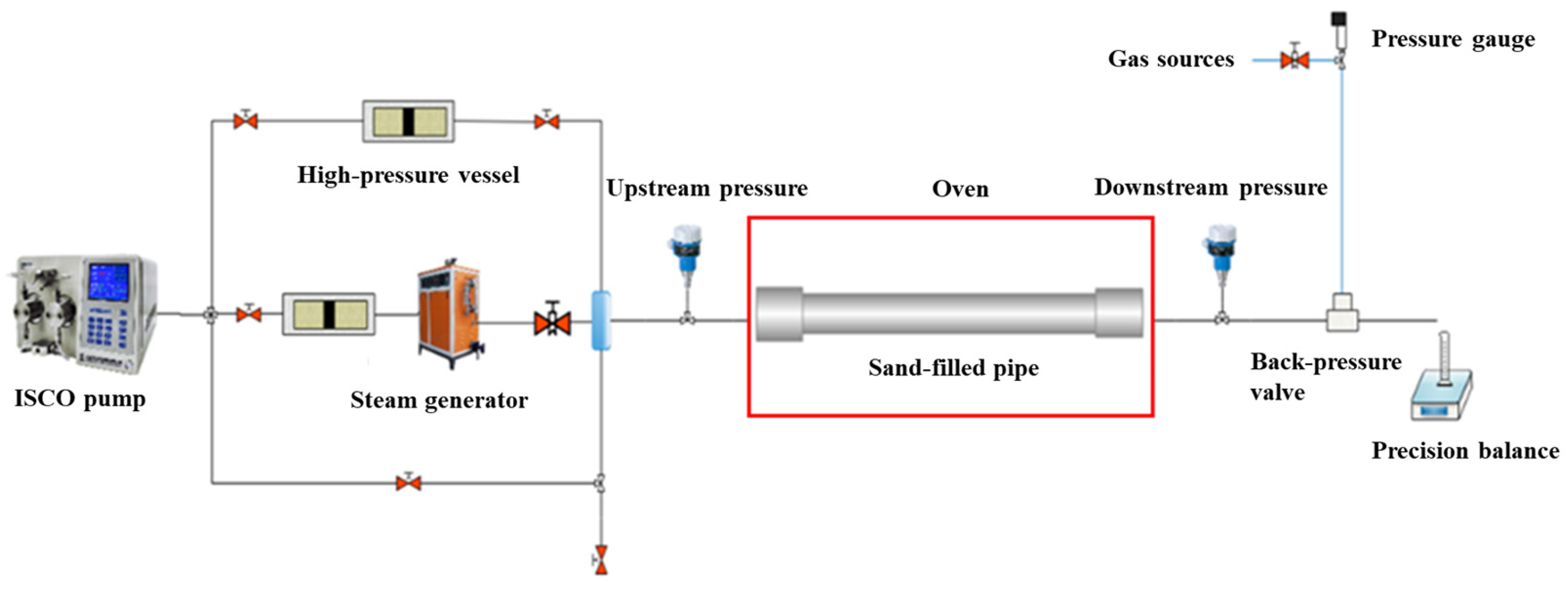
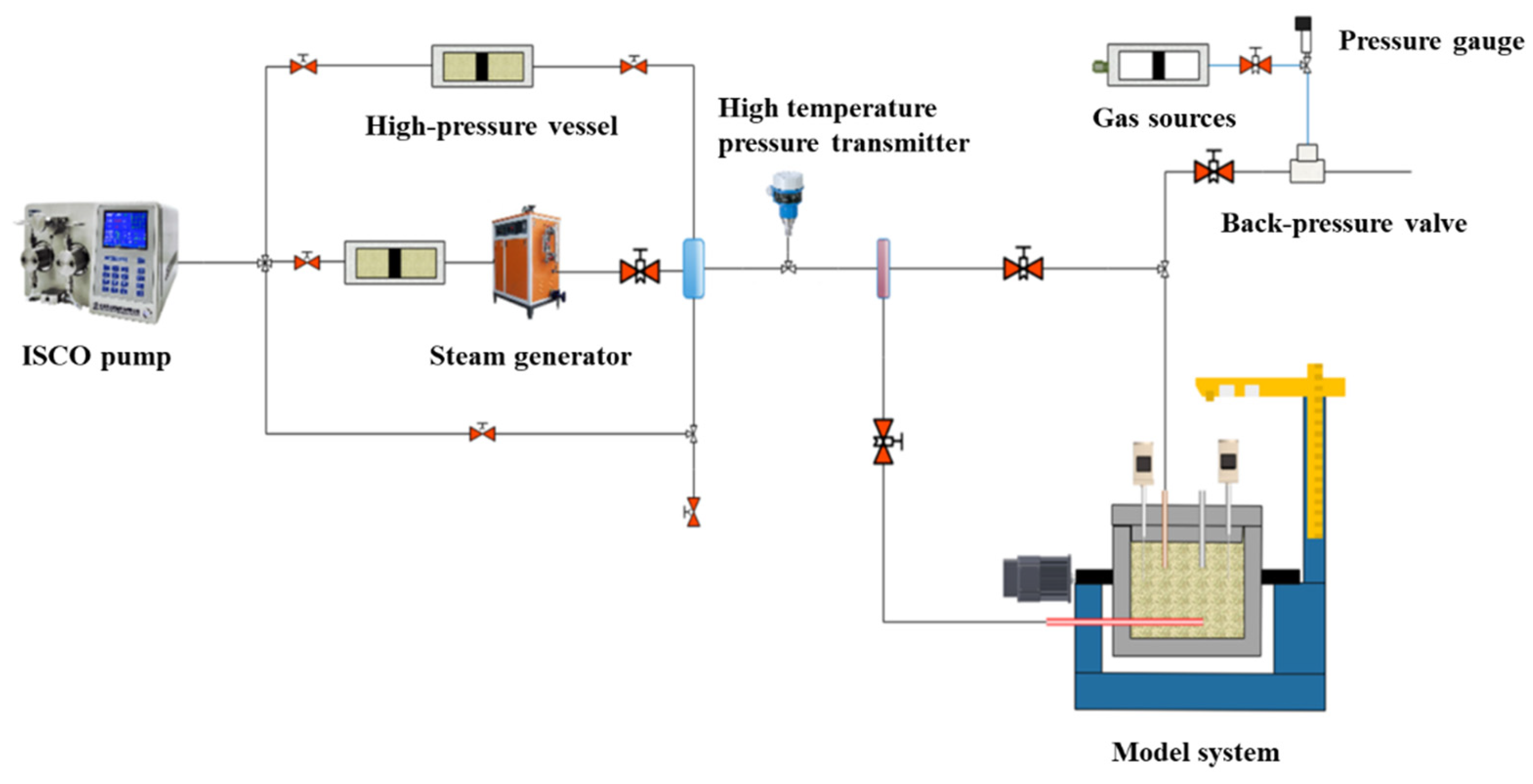
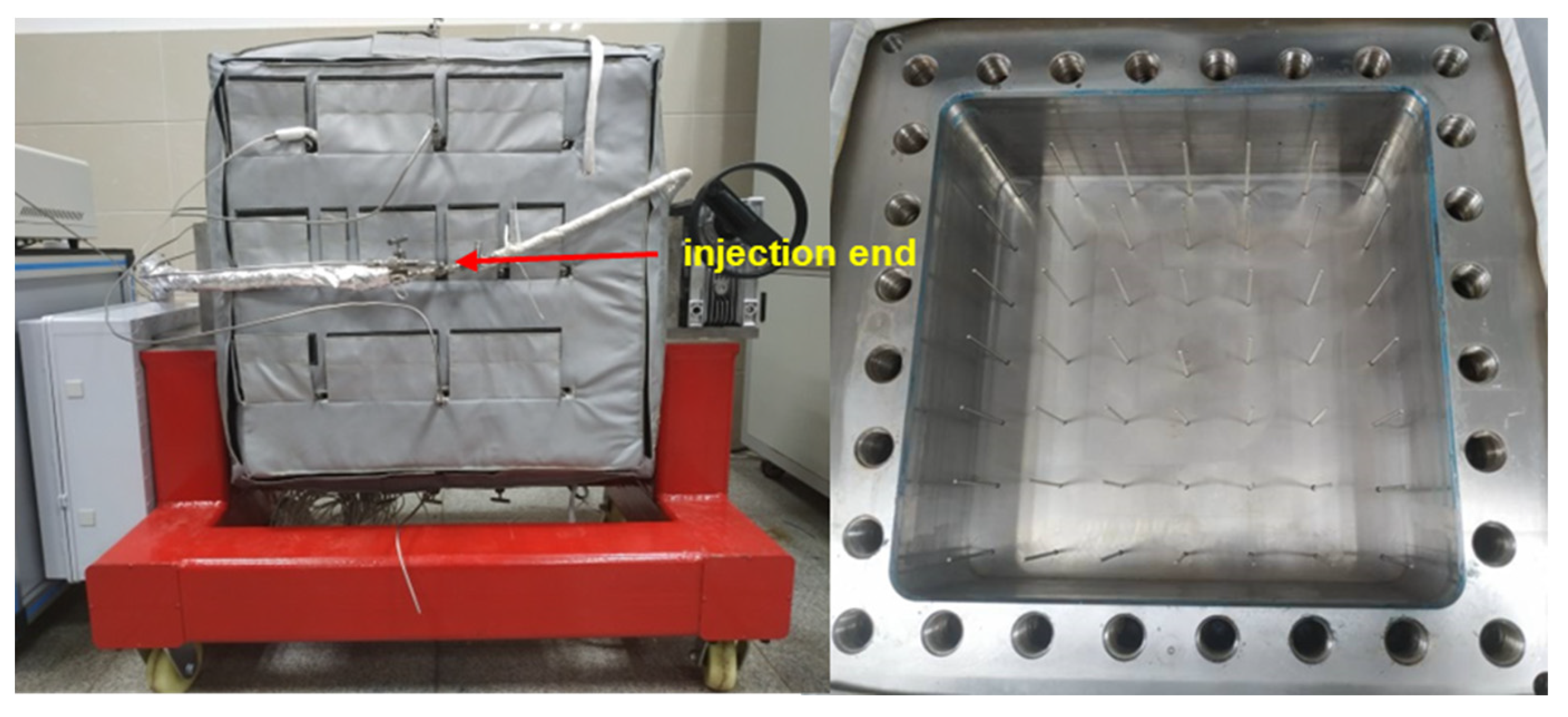


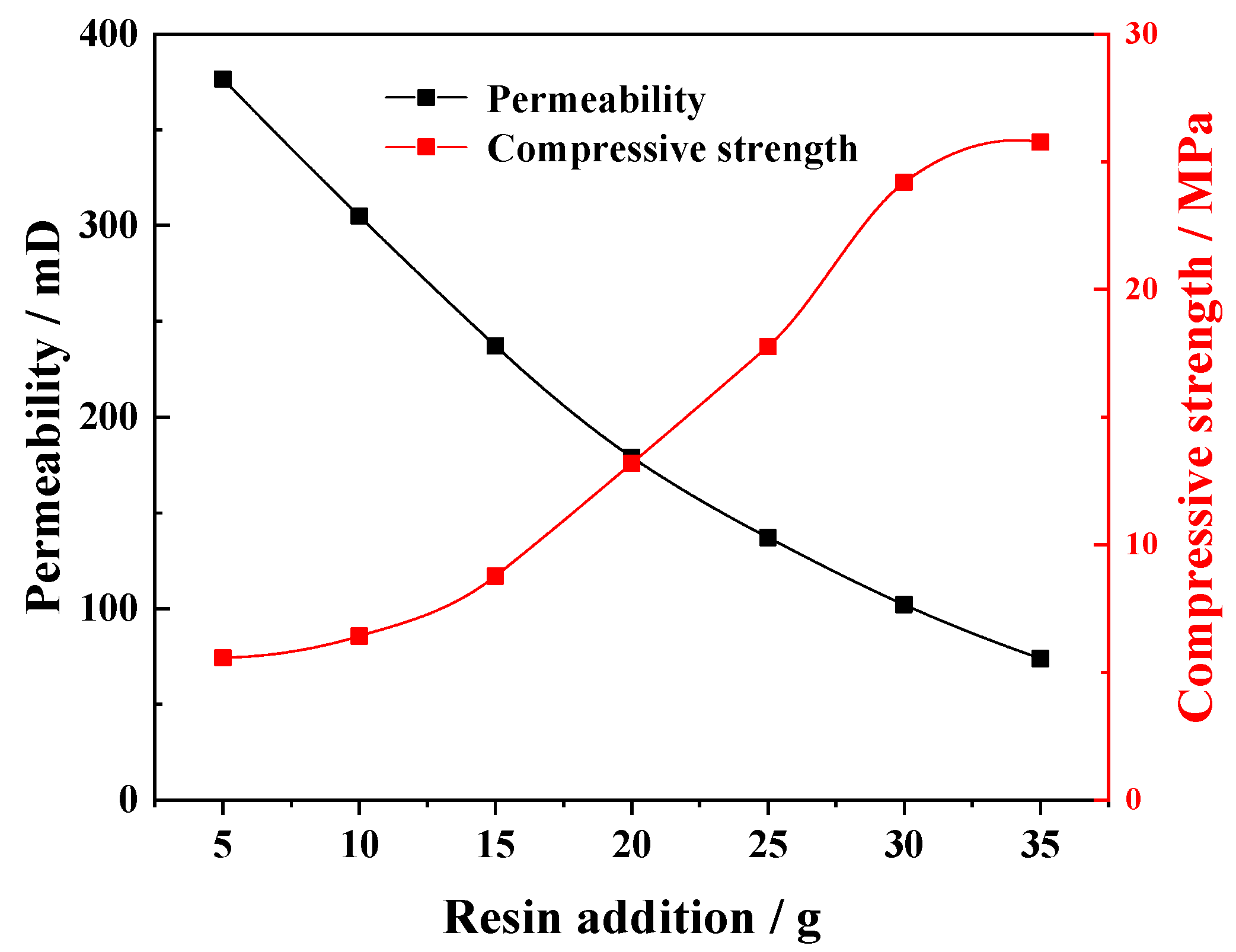





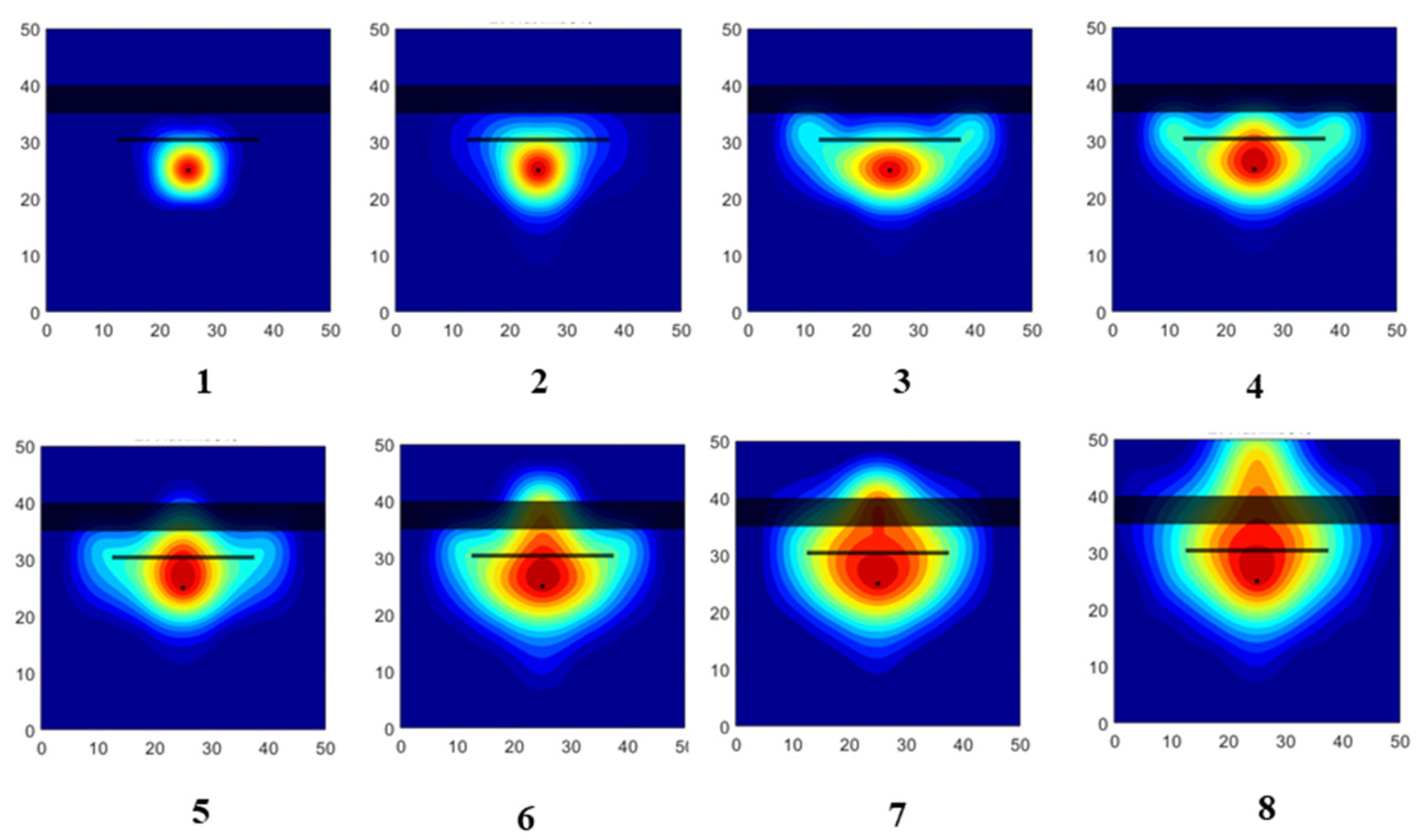

| Similarity Criterion | Physical Meanings | Simulation Parameters |
|---|---|---|
| The ratio between gravity and viscous force | Permeability/time | |
| The ratio between heat injection and heat loss | Steam quality | |
| transient conduction | Production time | |
| The dimensionless elastic energy | Comprehensive compressibility of formation | |
| The mass ratio between water equivalent and mobile oil | steam injection speed |
| Physical Property | Reservoir Data | Model Data |
|---|---|---|
| Oil density, kg/m3 | 953.8~1003.3 | 953.8~1003.3 |
| Oil viscosity, mPa·s | 53,203 | 53,203 |
| Thickness, m | 100 | 0.5 |
| Simulation of well length, m | 500 | 0.15 |
| Temperature, °C | 47 | 47 |
| Pressure, MPa | 10 | 10 |
| Permeability, mD | 3192 | 3192 |
| Porosity, % | 32.6 | 32.6 |
| Steam quality | 0.7~1.0 | 0.7~1.0 |
| Steam injection rate | 300 m3/d | 30 mL/min |
| Steam injection time | 25.33 d | 15.6 min |
| Top water thickness, m | 20 | 0.1 |
| Interlayer thickness, m | 10 | 0.05 |
| Sandwich layer thickness, m | 1.5 | 0.075 |
| Sandwich layer permeability, mD | 160 | 160 |
| No | Interlayer Permeability (mD) | Sandwich Layer Length | Distance between Horizontal Well and Interlayer/cm |
|---|---|---|---|
| 1 | 800 | —— | 10 |
| 2 | 200 | —— | 10 |
| 3 | 50 | —— | 10 |
| 4 | 200 | —— | 5 |
| 5 | 200 | 25 cm | 10 |
| Factor | A | B | C | |
|---|---|---|---|---|
| Level | 30% Curing Agent | 8% Diluent | 10% Flexibilizer | |
| 1 | 1-cyanoethyl-2-phenyl-4,5-bis (cyanoethoxymethylene) imidazole | Toluene glycidyl ether | Polypropylene glycol | |
| 2 | Methyl-5-norbornene-2,3-dicarboxylic anhydride | N-butyl glycidyl ether | Modified Nano—core Silicone Rubber | |
| 3 | 2-Phenyl-4-methyl-5-hydroxymethylimidazole | Styrene oxide | Acrylic rubber | |
| No | Influencing Factor | Evaluating Indicator | |||||
|---|---|---|---|---|---|---|---|
| Curing Agent (A) | Diluent (B) | Flexibilizer (C) | Viscosity/mPa·s | Curing Time/h | Compressive Strength/MPa | ||
| 1 | A1 | B1 | C1 | 103 | 1.5 | 46.60 | |
| 2 | A1 | B2 | C2 | 141 | 11 | 38.28 | |
| 3 | A1 | B3 | C3 | 209 | 3 | 44.62 | |
| 4 | A2 | B1 | C2 | 334 | 0.5 | 49.81 | |
| 5 | A2 | B2 | C3 | 435 | 17 | 23.88 | |
| 6 | A2 | B3 | C1 | 239 | 6 | 28.77 | |
| 7 | A3 | B1 | C3 | 349 | 4 | 29.43 | |
| 8 | A3 | B2 | C1 | 297 | 21 | 24.53 | |
| 9 | A3 | B3 | C2 | 294 | 2.5 | 23.54 | |
| Viscosity | k1 | 194.33 | 125.33 | 243.00 | |||
| k2 | 272.33 | 364.33 | 235.00 | ||||
| k3 | 269.33 | 246.33 | 258.00 | ||||
| R | 78.00 | 239.00 | 23.00 | ||||
| Curing time | k1 | 3.33 | 11.67 | 9.67 | |||
| k2 | 10.83 | 9.50 | 11.17 | ||||
| k3 | 18.50 | 11.50 | 12.00 | ||||
| R | 15.17 | 2.17 | 2.33 | ||||
| Compressive strength | k1 | 33.17 | 37.61 | 25.63 | |||
| k2 | 37.49 | 32.23 | 43.88 | ||||
| k3 | 35.83 | 36.64 | 36.98 | ||||
| R | 4.32 | 5.38 | 18.24 | ||||
| Factor | A | B | C | |
|---|---|---|---|---|
| Level | Curing Agent Content/% | Diluent Content/% | Flexibilizer Content/% | |
| 1 | 25 | 5 | 6 | |
| 2 | 30 | 10 | 10 | |
| 3 | 35 | 15 | 14 | |
| No | Influencing Factor | Evaluating Indicator | |||||
|---|---|---|---|---|---|---|---|
| Curing Agent (A) | Diluent (B) | Flexibilizer (C) | Viscosity/mPa·s | Curing Time/h | Compressive Strength/MPa | ||
| 1 | A1 | B1 | C1 | 122 | 11 | 39.36 | |
| 2 | A1 | B2 | C2 | 87 | 16 | 45.52 | |
| 3 | A1 | B3 | C3 | 54 | 21 | 47.65 | |
| 4 | A2 | B1 | C2 | 129 | 14 | 44.33 | |
| 5 | A2 | B2 | C3 | 94 | 13 | 46.26 | |
| 6 | A2 | B3 | C1 | 66 | 10 | 34.56 | |
| 7 | A3 | B1 | C3 | 132 | 5.5 | 49.39 | |
| 8 | A3 | B2 | C1 | 116 | 7 | 33.34 | |
| 9 | A3 | B3 | C2 | 68 | 3.5 | 45.88 | |
| Viscosity | k1 | 87.67 | 127.67 | 101.33 | |||
| k2 | 96.33 | 99.00 | 94.67 | ||||
| k3 | 105.33 | 62.67 | 93.33 | ||||
| R | 17.67 | 65.00 | 8.00 | ||||
| Curing time | k1 | 16.00 | 10.17 | 9.33 | |||
| k2 | 12.33 | 12.00 | 11.17 | ||||
| k3 | 5.33 | 11.50 | 13.17 | ||||
| R | 10.67 | 1.83 | 3.83 | ||||
| Compressive strength | k1 | 44.18 | 44.36 | 35.75 | |||
| k2 | 41.72 | 41.71 | 45.24 | ||||
| k3 | 42.87 | 42.70 | 47.77 | ||||
| R | 2.46 | 2.65 | 12.01 | ||||
| Lithology | Permeability/mD | Rative Error/% | Breakthrough Pressure Gradient/Pa/m | Rative Error/% | ||
|---|---|---|---|---|---|---|
| Interlayer Core | Simulated Interlayer | Interlayer Core | Simulated Interlayer | |||
| Gavel rock | 42.17 | 45.32 | 7.47 | 18.99 | 18.67 | 1.69 |
| 160.05 | 151.76 | 5.18 | 1.29 | 1.32 | 2.33 | |
| 910.26 | 887.91 | 2.46 | 0.97 | 1.01 | 4.12 | |
Disclaimer/Publisher’s Note: The statements, opinions and data contained in all publications are solely those of the individual author(s) and contributor(s) and not of MDPI and/or the editor(s). MDPI and/or the editor(s) disclaim responsibility for any injury to people or property resulting from any ideas, methods, instructions or products referred to in the content. |
© 2023 by the authors. Licensee MDPI, Basel, Switzerland. This article is an open access article distributed under the terms and conditions of the Creative Commons Attribution (CC BY) license (https://creativecommons.org/licenses/by/4.0/).
Share and Cite
Fan, H.; Fan, T.; Deng, J.; Zhang, L.; Zheng, W.; Chen, L.; Ge, Z.; Xie, H.; Liang, X. The Influence of Interlayer on the Development of Steam Chamber in Steam Stimulation during Heavy Oil Recovery. Processes 2023, 11, 1742. https://doi.org/10.3390/pr11061742
Fan H, Fan T, Deng J, Zhang L, Zheng W, Chen L, Ge Z, Xie H, Liang X. The Influence of Interlayer on the Development of Steam Chamber in Steam Stimulation during Heavy Oil Recovery. Processes. 2023; 11(6):1742. https://doi.org/10.3390/pr11061742
Chicago/Turabian StyleFan, Hongjun, Tingen Fan, Junhui Deng, Lijun Zhang, Wei Zheng, Lifeng Chen, Zunzeng Ge, Haojun Xie, and Xu Liang. 2023. "The Influence of Interlayer on the Development of Steam Chamber in Steam Stimulation during Heavy Oil Recovery" Processes 11, no. 6: 1742. https://doi.org/10.3390/pr11061742
APA StyleFan, H., Fan, T., Deng, J., Zhang, L., Zheng, W., Chen, L., Ge, Z., Xie, H., & Liang, X. (2023). The Influence of Interlayer on the Development of Steam Chamber in Steam Stimulation during Heavy Oil Recovery. Processes, 11(6), 1742. https://doi.org/10.3390/pr11061742







